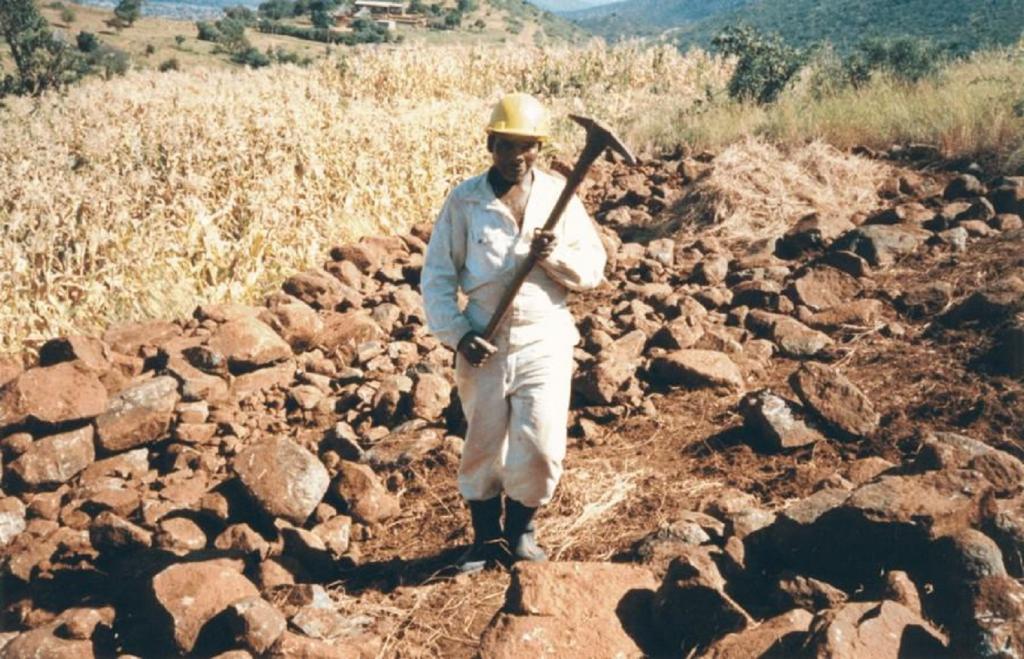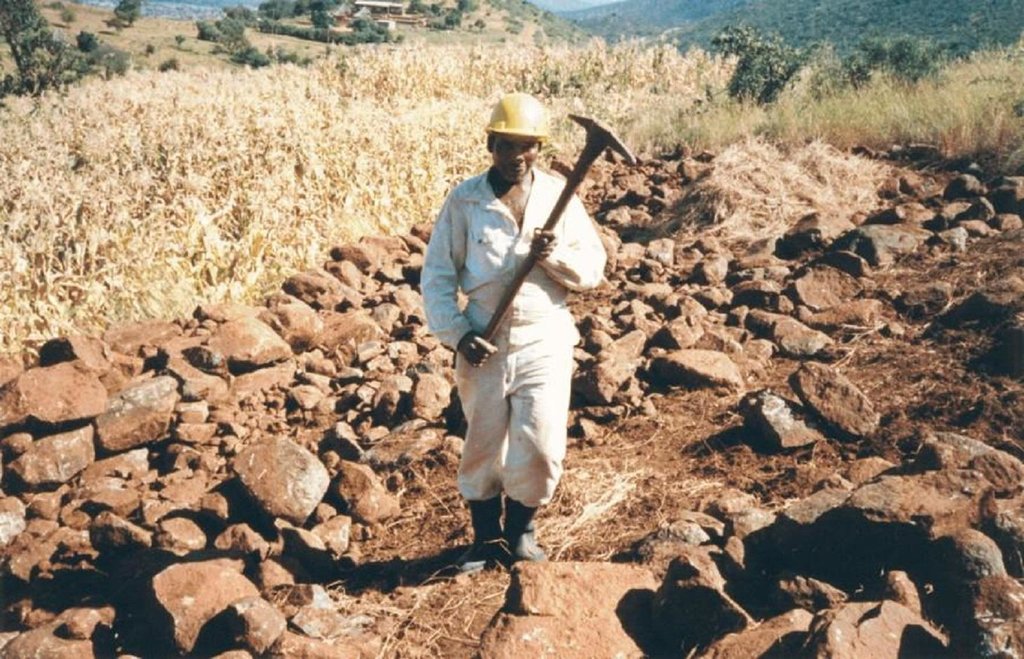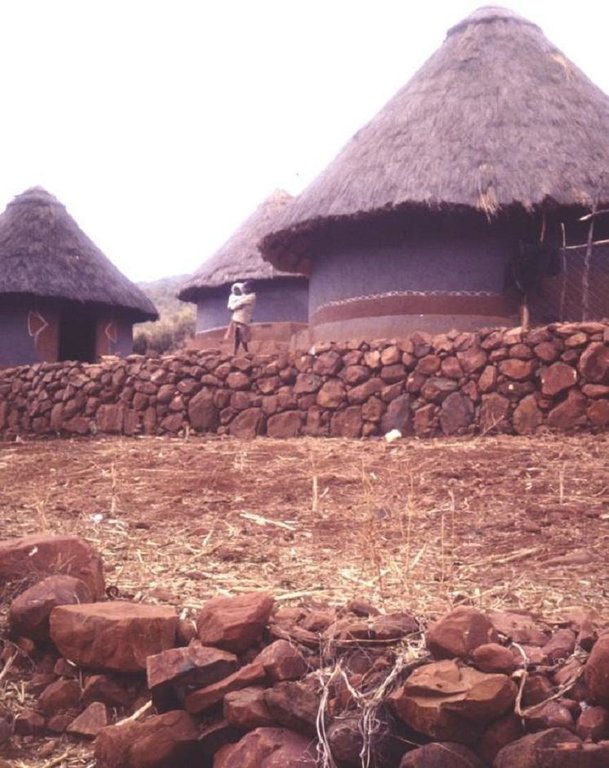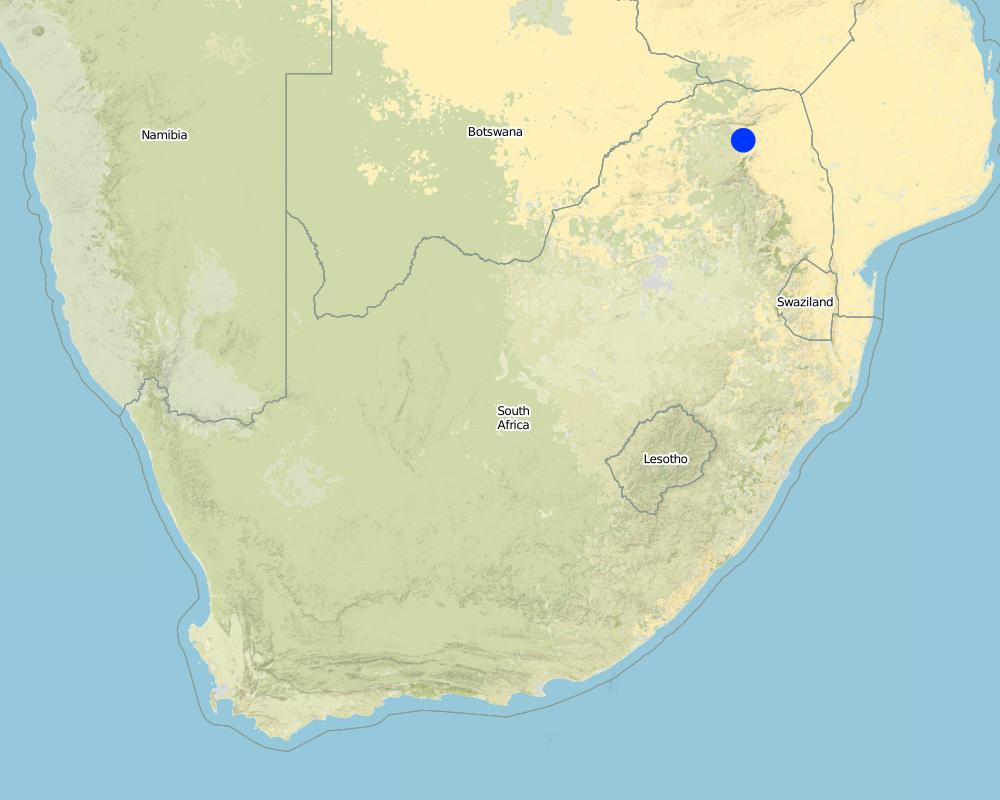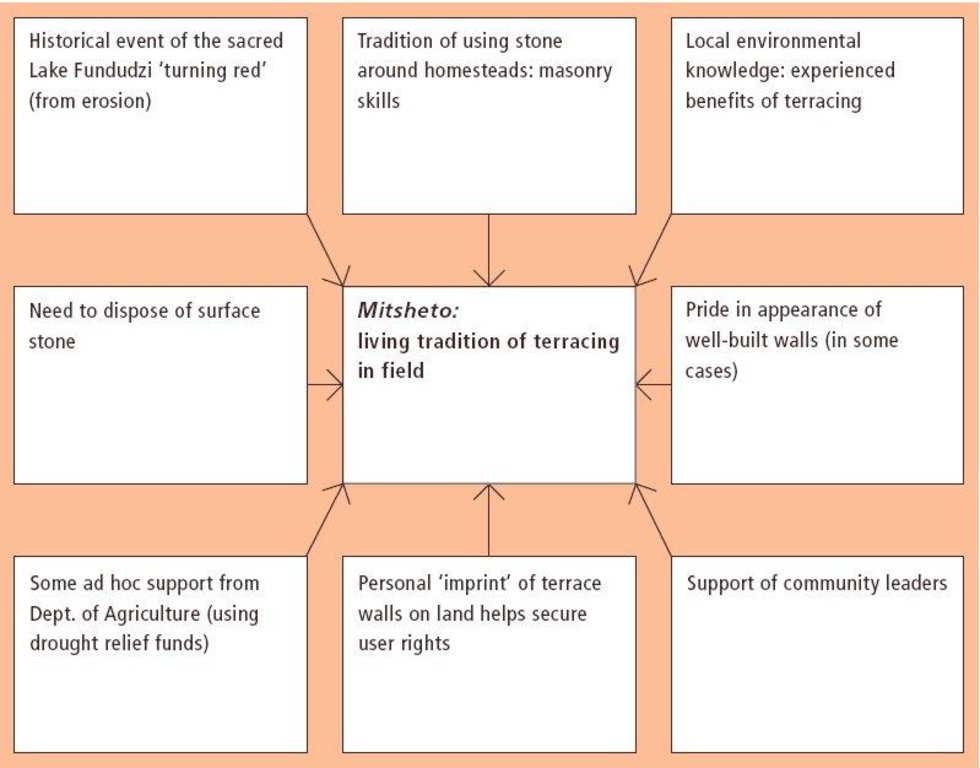Community tradition [แอฟริกาใต้]
- ผู้สร้างสรรค์:
- การอัพเดท:
- ผู้รวบรวม: William Critchley
- ผู้เรียบเรียง: –
- ผู้ตรวจสอบ: Fabian Ottiger, Deborah Niggli
approaches_2625 - แอฟริกาใต้
ดูส่วนย่อย
ขยายทั้งหมด ย่อทั้งหมด1. ข้อมูลทั่วไป
1.2 รายละเอียดที่ติดต่อได้ของผู้รวบรวมและองค์กรที่เกี่ยวข้องในการประเมินและการจัดเตรียมทำเอกสารของแนวทาง
ผู้เชี่ยวชาญ SLM:
Van der Merwe Rinda
rinda@arc.agric.za
Institute for Soil, Climate and Water
P/Bag x79, 0001 Pretoria, South Africa
แอฟริกาใต้
ชื่อของโครงการซึ่งอำนวยความสะดวกในการทำเอกสารหรือการประเมินแนวทาง (ถ้าเกี่ยวข้อง)
Book project: where the land is greener - Case Studies and Analysis of Soil and Water Conservation Initiatives Worldwide (where the land is greener)ชื่อของโครงการซึ่งอำนวยความสะดวกในการทำเอกสารหรือการประเมินแนวทาง (ถ้าเกี่ยวข้อง)
Institute for Soil, Climate & Water - แอฟริกาใต้1.3 เงื่อนไขที่เกี่ยวข้องกับการใช้ข้อมูลที่ได้บันทึกไว้ผ่านทาง WOCAT
ผู้รวบรวมและวิทยากรหลักยอมรับเงื่อนไขเกี่ยวกับการใช้ข้อมูลที่ถูกบันทึกผ่านทาง WOCAT:
ใช่
1.4 การอ้างอิงถึงแบบสอบถามเรื่องเทคโนโลยี SLM
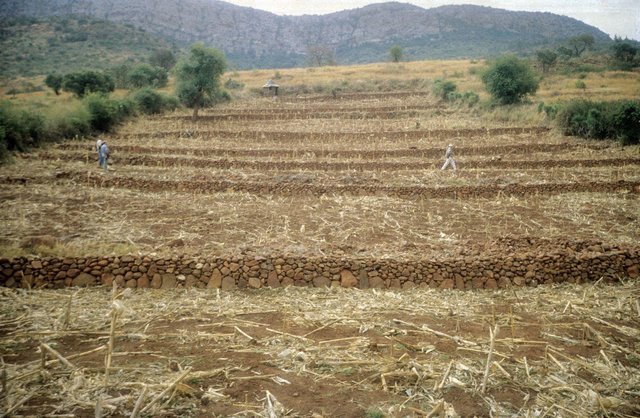
Traditional stone wall terraces [แอฟริกาใต้]
Stone walls built on sloping fields to create terraces for cultivation and conservation: both ancient and contemporary.
- ผู้รวบรวม: William Critchley
2. คำอธิบายของแนวทาง SLM
2.1 การอธิบายแบบสั้น ๆ ของแนวทาง
Inherited, and still practiced, tradition of stone terracing - passed down from generation to generation.
2.2 การอธิบายอย่างละเอียดของแนวทาง
การอธิบายอย่างละเอียดของแนวทาง:
Aims / objectives: The VhaVenda people of Limpopo Province in South Africa have a tradition of building with stone which has been passed down from generation to generation. They construct stone walls around their houses for example, taking a pride in the appearance of their homesteads. There is a historical monument nearby, the stone-built kraal at Dzata, the ruins of which are situated within a few kilometres of the study location. There may even be some evidence that the VhaVenda came originally from the area of the Great Zimbabwe (the famous stone-built fortress in Zimbabwe). It is not surprising therefore that the VhaVenda have used their masonry skills to build terraces in fields to counter erosion and simultaneously to make cultivation - along the contour by oxen - possible. This tradition has been passed down through the ages: it is institutionalised in the community and is practised together by men, women and children on a family basis. It is encouraged by community leaders: a particular example of this was in the 1960s when local chiefs were concerned at the sacred Lake Fundudzi 'turning red' - with sediment eroded from the land - and as a result they launched a conservation campaign to prevent soil wash into the lake. There has been modest and occasional support by the Department of Agriculture, in the form of ad hoc drought relief funds. There is quite a range of technical ability/care taken in terracing. Some walls are meticulously built; others are merely piles of stone across the slope. One of the reasons for this is that work tends to be done on an individual basis. Another result is that fields may take two years or more to be fully terraced. What is evident is that the land users - as well as being experienced masons -appreciate the benefits of the terraces they construct. An investigation of local environmental knowledge and conservation practices has demonstrated this clearly (see reference).
Methods: The causes of erosion were explained by the interviewees as being part natural (rainfall, slope etc) and part anthropogenic (poor road building, up and down ploughing, burning of grassland etc). The main negative impact of erosion was considered to be loss of soil fertility: hence terracing for protection. This indigenous knowledge also extends to soils: eight local soil types and their differences in terms of texture, fertility and erodibility are recognised in the study area.
2.3 รูปภาพของแนวทาง
2.5 ประเทศ ภูมิภาค หรือสถานที่ตั้งที่ได้นำแนวทางไปใช้
ประเทศ:
แอฟริกาใต้
ภูมิภาค/รัฐ/จังหวัด: :
Limpopo Province
Map
×2.7 ประเภทของแนวทาง
- แบบดั้งเดิม/ แบบพื้นเมิอง
2.8 เป้าหมายหรือวัตถุประสงค์หลักของแนวทาง
The objective of the local people is simply to continue making cultivation possible and sustainable, through the local tradition of using stone walls to create terraces and to remove abundant stones from the field.
The SLM Approach addressed the following problems: - the tradition presumably arose as a spontaneous local response to degradation: it remains well entrenched - underlying problems of no flat land to cultivate, soil erosion/fertility decline on sloping fields, and loose stone and rocks impeding animal-draw ploughs
2.9 เงื่อนไขที่เอื้ออำนวยหรือเป็นอุปสรรคต่อการนำเทคโนโลยีภายใต้แนวทางนี้ไปปฏิบัติใช้
อื่นๆ
- เป็นอุปสรรค
labour: High labour demand to remove stone from inhibiting cultivation.
Treatment through the SLM Approach: Traditional teaching that such stone can be used constructively to improve conservation and yield benefits.
3. การมีส่วนร่วมและบทบาทของผู้มีส่วนได้ส่วนเสียที่เกี่ยวข้อง
3.1 ผู้มีส่วนได้ส่วนเสียที่เกี่ยวข้องในแนวทางนี้และบทบาท
- ผู้ใช้ที่ดินระดับท้องถิ่นหรือชุมชนระดับท้องถิ่น
3.2 การเกี่ยวข้องของผู้ใช้ที่ดินระดับท้องถิ่นหรือชุมชนระดับท้องถิ่นในช่วงต่างๆของแนวทาง
| ความเกี่ยวข้องของผู้ใช้ที่ดินระดับท้องถิ่นหรือชุมชนระดับท้องถิ่น | ระบุผู้ที่มีส่วนเกี่ยวข้องและอธิบายกิจกรรม | |
|---|---|---|
| การริเริ่มหรือการจูงใจ | ระดมกำลังด้วยตนเอง | passing on knowledge; passing on of knowledge from generation to generation |
| การวางแผน | ระดมกำลังด้วยตนเอง | |
| การดำเนินการ | ระดมกำลังด้วยตนเอง | family-based (or individual) construction |
| การติดตามตรวจสอบหรือการประเมินผล | ไม่มี | |
| Research | ไม่มี |
3.3 แผนผังแสดงขั้นตอนการทำงาน (ถ้ามี)
3.4 การตัดสินใจเลือกใช้เทคโนโลยี SLM
ระบุผู้ที่ทำการตัดสินใจเลือกเทคโนโลยีมากกว่าหนึ่งวิธีไปปฏิบัติใช้:
- ผู้ใช้ที่ดินเพียงผู้เดียว ( ริเริ่มด้วยตัวเอง)
การอธิบาย:
Decisions on the method of implementing the SLM Technology were made by by land users* alone (self-initiative / bottom-up)
4. การสนับสนุนด้านเทคนิค การสร้างขีดความสามารถ และการจัดการด้านความรู้
4.1 การสร้างขีดความสามารถ / การอบรม
ได้มีการจัดอบรมให้แก่ผู้ใช้ที่ดินหรือผู้มีส่วนได้ส่วนเสียคนอื่น ๆ หรือไม่:
ใช่
หัวข้อที่พูด:
There was/is no formal training - just father to son/mother to daughter.
4.2 การบริการให้คำแนะนำ
ผู้ใช้ที่ดินมีการเข้าถึงการรับบริการให้คำปรึกษาหรือไม่:
ใช่
ระบุว่ามีบริการให้คำปรึกษาหรือไม่:
- ไปเยี่ยมชมสถานที่
การอธิบาย/แสดงความคิดเห็น:
Key elements: Some encouragement from Department of Agriculture especially during soil and water conservation campaigns/drought relief periods.
4.3 การเสริมความแข็งแกร่งให้กับสถาบัน (การพัฒนาองค์กร)
สถาบันได้รับการจัดตั้งขึ้นมาหรือเสริมความแข็งแกร่งโดยแนวทางนี้หรือไม่:
- ใช่ เล็กน้อย
ระบุระดับของสถาบันที่ได้รับการเสริมความแข็งแกร่งหรือจัดตั้งขึ้นมา:
- ท้องถิ่น
ให้รายละเอียดเพิ่มเติม :
support for SWC campaigns from local leaders
4.4 การติดตามตรวจสอบและประเมินผล
การติดตามตรวจสอบและประเมินผลเป็นส่วนหนึ่งของแนวทางหรือไม่:
ใช่
ความคิดเห็น:
bio-physical aspects were ad hoc monitored through observations
technical aspects were ad hoc monitored through observations; indicators
economic / production aspects were ad hoc monitored through observations
area treated aspects were ad hoc monitored through observations
There were no changes in the Approach as a result of monitoring and evaluation
5. การสนับสนุนด้านการเงินและวัสดุอุปกรณ์
5.1 ระบุงบประมาณประจำปีสำหรับแนวทาง SLM นี้
แสดงความคิดเห็น (แหล่งของการระดมทุน ผู้บริจาคคนสำคัญ):
Approach costs were met by the following donors: government (national): 5.0%; local community / land user(s) (-): 95.0%
5.2 การสนับสนุนด้านการเงิน / วัสดุอุปกรณ์ให้แก่ผู้ใช้ที่ดิน
ผู้ใช้ที่ดินได้รับการสนับสนุนด้านการเงิน / วัสดุอุปกรณ์ไปปฏิบัติใช้เทคโนโลยีหรือไม่:
ไม่ใช่
5.3 เงินสนับสนุนสำหรับปัจจัยนำเข้า (รวมถึงแรงงาน)
ถ้าแรงงานโดยผู้ใช้ที่ดินเป็นปัจจัยนำเข้าที่มีอยู่มากมาย ระบุด้วยว่าเนื่องจาก:
- สมัครใจ
ความคิดเห็น:
Almost entirely voluntary: some small support (approx 5% of the sample monitored) through Government during times of food scarcity with paid relief work.
A (very) small amount of drought relief in recent years from Government
5.4 เครดิต
มีการจัดหาเครดิตมาให้ภายใต้แนวทาง SLM หรือไม่:
ไม่ใช่
6. การวิเคราะห์ผลกระทบและการสรุป
6.1 ผลกระทบของแนวทาง
ช่วยให้ผู้ใช้ที่ดินนำเอาเทคโนโลยี SLMไปใช้และบำรุงรักษาสภาพไว้ได้หรือไม่:
- ไม่ใช่
- ใช่ เล็กน้อย
- ใช่ ปานกลาง
- ใช่ อย่างมาก
Great: as part and parcel of the local tradition - for example contour ploughing is facilitated by the fact that the stone lines are on the contour, making this type of ploughing easier.
Did other land users / projects adopt the Approach?
- ไม่ใช่
- ใช่ เล็กน้อย
- ใช่ ปานกลาง
- ใช่ อย่างมาก
Only within this small pocket of Thohoyandou District (as far as known).
6.3 ความยั่งยืนของกิจกรรมของแนวทาง
ผู้ใช้ที่ดินสามารถทำให้สิ่งต่างๆ ที่ได้ปฏิบัติใช้โดยแนวทางนี้ยั่งยืนได้หรือไม่ (โดยไม่มีการสนับสนุนจากภายนอก):
- ใช่
ถ้าตอบว่าใช่ ให้อธิบายว่าอย่างไร :
The VhaVenda have built terraces for generations so far, so no reason to think that things will change.
6.4 จุดแข็งและข้อได้เปรียบของแนวทาง
| จุดแข็ง / ข้อได้เปรียบของแนวทางในทัศนคติของผู้รวบรวมหรือวิทยากรหลัก |
|---|
| Traditional approaches have the potential to endure (How to sustain/ enhance this strength: Acknowledgement and encouragement by the Government and/or NGOs will help this.) |
6.5 จุดอ่อน / ข้อเสียเปรียบของแนวทางและวิธีในการแก้ไข
| จุดอ่อน / ข้อเสียเปรียบในทัศนคติของผู้รวบรวมหรือวิทยากรหลัก | สามารถแก้ไขปัญหาได้อย่างไร |
|---|---|
| This tradition was largely unrecognised until recently: therefore an opportunity was lost to encourage people and help the approach spread | Publicise widely and carry out farmer-to-farmer/community-to-community visits to further its spread and the spread of local SWC knowledge more generally. |
7. การอ้างอิงและการเชื่อมต่อ
7.1 วิธีการหรือแหล่งข้อมูล
- ไปเยี่ยมชมภาคสนาม การสำรวจพื้นที่ภาคสนาม
- การสัมภาษณ์กับผู้ใช้ที่ดิน
7.2 การอ้างอิงถึงสิ่งตีพิมพ์
ชื่อเรื่อง ผู้เขียน ปี ISBN:
Critchley W and Netshikhovehla E (1998) Conventional views, changing paradigms and a tradition of soil conservation.
ลิงก์และโมดูล
ขยายทั้งหมด ย่อทั้งหมดลิงก์

Traditional stone wall terraces [แอฟริกาใต้]
Stone walls built on sloping fields to create terraces for cultivation and conservation: both ancient and contemporary.
- ผู้รวบรวม: William Critchley
โมดูล
ไม่มีโมดูล


